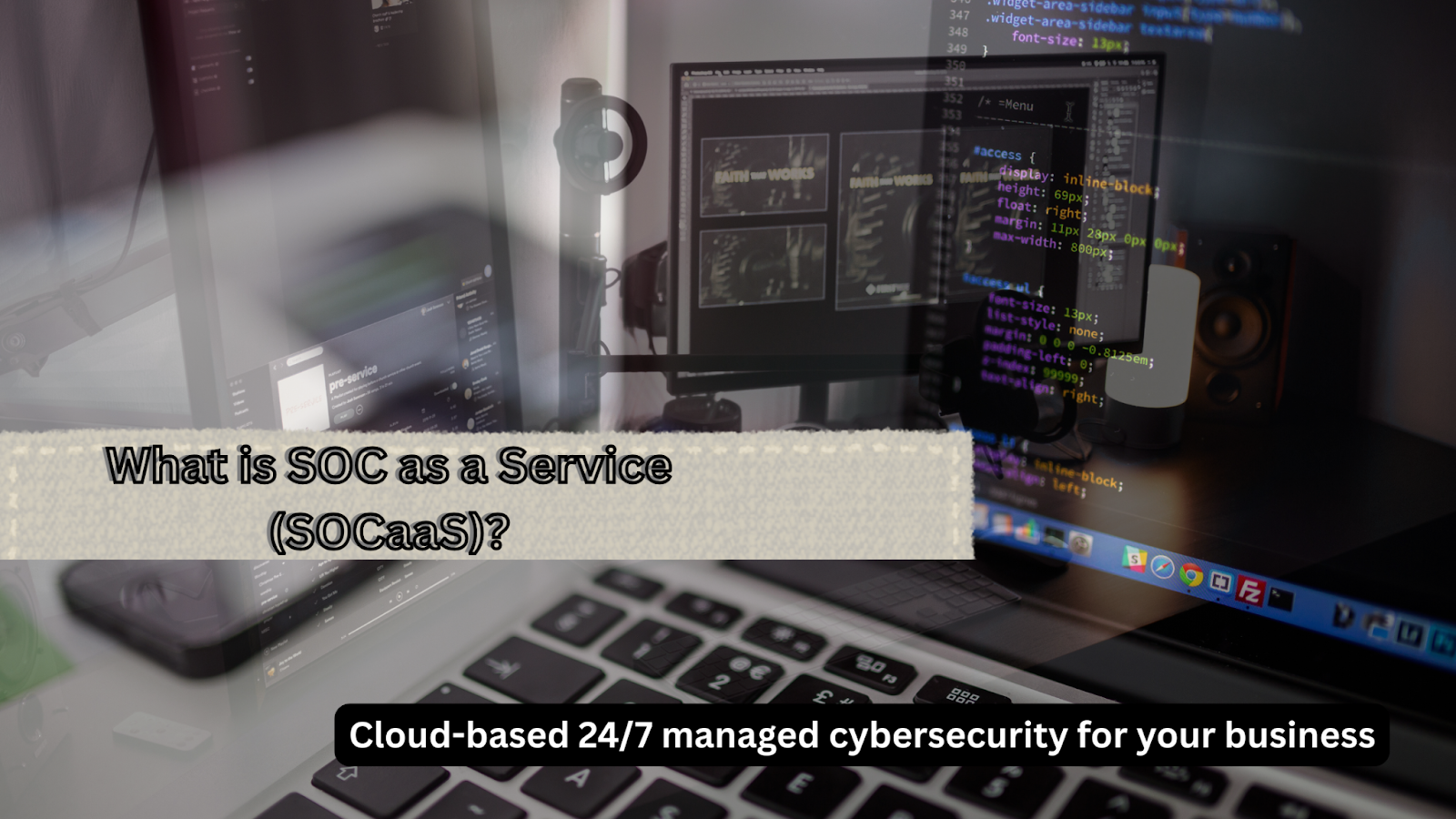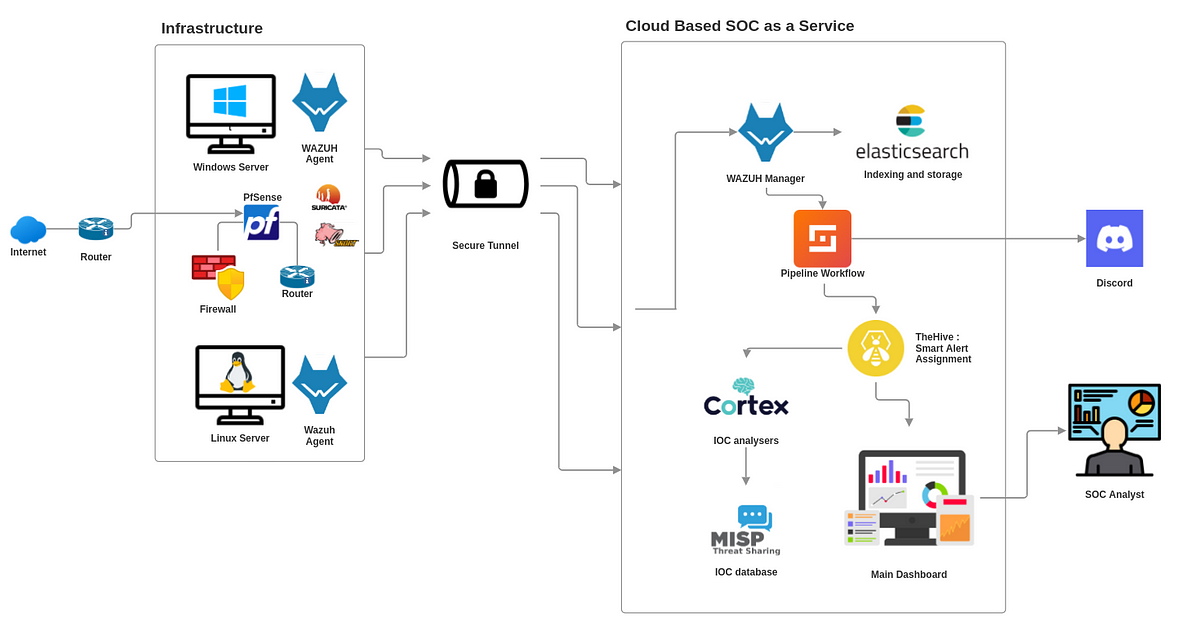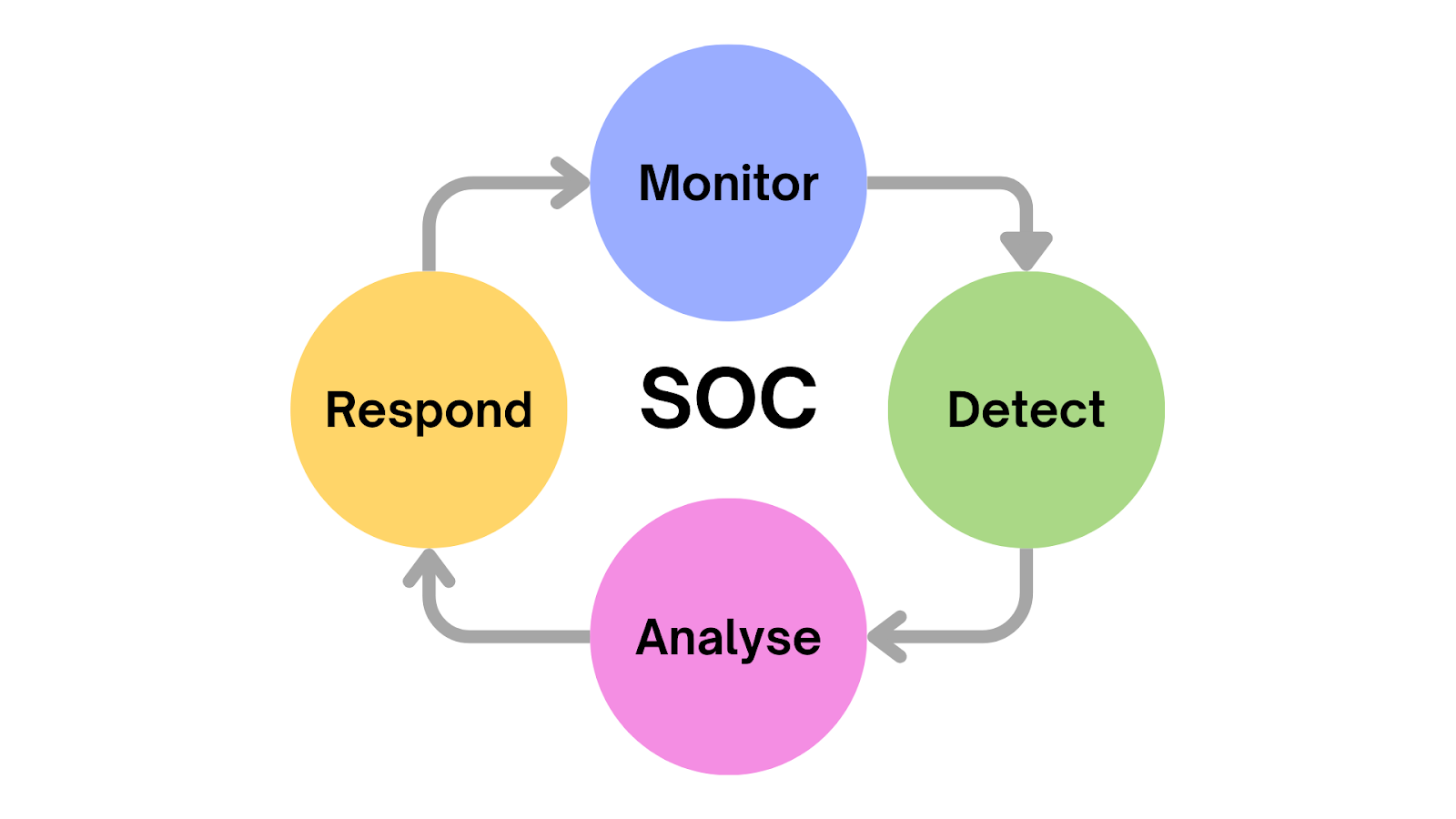Cyber-Attacks are evolving faster than ever, and in 2025, businesses can no longer afford weak cybersecurity. Just one successful breach can disrupt operations, drain finances, and damage customer trust. However, building and maintaining an in-house Security Operations Center (SOC) is expensive, complex, and requires highly skilled professionals who are difficult to find.

This is where SOC as a Service (SOCaaS) comes in. It’s a cloud model of outsourced managed security with 24/7 threat detection, monitoring, and incident response for fewer dollars than to operate an in-house SOC. Organizations are abandoning security models for SOCaaS because it provides scalability, affordability, and 24/7 experienced coverage.
In this guide, we’ll explore what SOCaaS is, how it works, its key benefits, challenges, and why it’s becoming the go-to cybersecurity solution in 2025.
- What is SOC as a Service (SOCaaS)?
- How does SOC as a Service (SOCaaS) Works?
- Key Advantages of SOC as a Service (SOCaaS)
- Cyber Threats Monitored by SOC as a Service (SOCaaS)
- SOC as a Service (SOCaaS) Challenges
- Who Should Implement SOC as a Service (SOCaaS)?
- SOC as a Service (SOCaaS) future in 2025
- Why SOCaaS Is the Future of Cybersecurity
- FAQs
What is SOC as a Service (SOCaaS)?

SOC as a Service (SOCaaS) is a cloud-delivered subscription service delivering managed security operations to enterprises. Instead of investing tremendous amounts of infrastructure, technology, and trained security personnel in establishing and operating a Security Operations Center (SOC) in-house, organizations can outsource threat identification, detection, and response to trained cybersecurity providers.
Here is how it Differs from a Traditional SOC
- Traditional SOC: Requires an high upfront investment in infrastructure, equipment, and experienced security talent.
- SOCaaS: Provides enterprise-level (or better) security protection as a pay-as-you-go option with 24/7 monitoring and expert threat response.
That is to say, SOCaaS offers enterprise-level security without the expense and hassle of attempting to do it on your own.
It’s subscription-based, so organizations can grow their security requirements as they grow, meet regulatory needs, or react to changing cyber threats, making it suitable for any sized organization.
How does SOC as a Service (SOCaaS) Works?

SOCaaS is an external security team with next-generation tools, high-caliber analysts, and ongoing 24/7 monitoring to protect your digital assets. Below is step by step how it works:
1. 24/7 Threat Detection & Monitoring
- 24/7 monitors endpoints, networks, cloud infrastructures, and applications.
- SIEM tools collect and process in real-time security incidents.
2. AI-Driven Analytics & Threat Intelligence
- Utilizes global threat intelligence feeds and machine learning to detect abnormal patterns.
- Identifies current threats and emerging threats like malware, zero-day attacks, ransomware, and phishing.
3. Incident Response & Remediation
- SOCaaS staff respond quickly to a perceived threat.
- Conducts rapid containment and mitigation to limit its effect.
4. Reporting & Compliance Support
- Provides comprehensive security reports.
- Enables industry regulation compliance like GDPR, HIPAA, PCI DSS through the keeping of audit-ready security logs.
5. Continuous Improvement
- Leverages past incidents to enhance future threat detection.
- Continuously updates security configurations and policies.
In a nutshell, SOCaaS is a round-the-clock security periphery that protects companies without needing to keep an in-house SOC.
Recommended Read: 5 Best SOC 2 Compliance Software for 2024
Key Advantages of SOC as a Service (SOCaaS)
SOCaaS offers enterprise-level security without the expense or inconvenience of in-house SOC. The largest benefits are the following:
1. Cost Savings Compared to In-House SOC
- No need for expensive infrastructure or the extensive security personnel.
- Pay-as-you-go or subscription model within the reach of SMBs and organizations alike.
2. 24/7 Real-Time Monitoring
- 24-hour security protection that detects and reacts to threats in real-time.
- Reduces downtime and lessens the impact of cyberattacks.
3. Advanced Detection & Response
- Employing AI-driven analytics and global threat intelligence, SOCaaS detects attacks earlier than traditional means.
- Data breach risk minimized through swift incident response.
4. Expert Security Team Access
- Access trained cybersecurity experts without onboarding internal personnel.
- Threat hunting, analysis, and remediation executed by analysts.
5. Scalability & Flexibility
- Scalable to your changing business and IT environment.
- Multi-cloud, hybrid, and remote work security needs met.
6. Enhanced Compliance & Reporting
- Aids in regulatory requirements such as GDPR, HIPAA, PCI DSS.
- Provides granular logs and reports for audits.
7. Reduction of Alert Fatigue
- Eliminates false positives, providing high-confidence alerts so that your IT staff can focus on mission-critical issues.
In simple words, SOCaaS combines state-of-the-art technology, expert professionals, and 24/7 surveillance to offer improved cybersecurity at a low cost.
Cyber Threats Monitored by SOC as a Service (SOCaaS)
SOCaaS always shields your entire digital ecosystem from the detection and prevention of all forms of cyber attacks. This is what it shields you from:
1. Malware & Ransomware Attacks
- Detects malicious software before it spreads.
- Blocks ransomware encrypting your data and demanding ransom.
2. Phishing, Spear-Phishing & Social Engineering
- Blocks email and web traffic to prevent credential-stealing attacks.
- Detects suspicious login or spoofed domain behaviour.
3. Insider Threats
- Pre-empts unusual user activity in your organisation.
- Blocks data theft or sabotage by employees or contractors.
4. Distributed Denial of Service (DDoS) Attacks
- Blocks network traffic floods that take your service down.
- Keep your sites and apps up for business.
5. Zero-Day Exploits
- With threat intelligence and AI to uncover unknown vulnerabilities.
- Prevents hackers from leveraging vulnerabilities prior to patch release.
6. Advanced Persistent Threats (APTs)
- Identifies persistent, hidden attacks where data is stolen under cover for an extended time.
7. Cloud & Endpoint Threats
- Protect workloads in secure cloud, hybrid, and on-premises environments.
- Secure laptops, servers, IoT, and mobile endpoints.
Because of 24/7 monitoring, SOCaaS never misses a threat, neither the most clever ones.
SOC as a Service (SOCaaS) Challenges
Even as SOCaaS offers full and cost-effective cybersecurity, business owners have some disadvantages to consider before implementation:
1. Data Privacy & Compliance Issues
- SOCaaS vendors need access to your network and sensitive data to monitor.
- This creates GDPR, HIPAA, PCI DSS compliance challenges, particularly in compliance-heavy sectors.
2. Lack of Personalization
- Managed SOC plans are created for the standard company and are not tailored specifically to individual processes or specialized systems.
3. Reliance on Third-Party Providers
- Having a third-party personnel at your disposal means less direct security control.
- If the vendor crashes or suffers delays, this will have an impact on response times.
4. Effort to Onboard & Integrate
- Setup involves deploying SOCaaS tools upon existing IT infrastructure, an effort and time-consuming process.
5. Storage & Access Fees
- A few SOCaaS providers incorporate a fee for longer data storage or unlimited logging, increasing overall costs.
Despite the drawbacks, SOCaaS remains lean and scalable if chosen from a qualified, open vendor.
Who Should Implement SOC as a Service (SOCaaS)?
SOCaaS is not meant for large corporations alone. Any company size will benefit from it. The following is who will need to implement it:
1. Small and Medium-Sized Enterprises
- This possess minimal or no dedicated security personnel or advanced tools.
- SOCaaS provides enterprise-grade protection at a cost not spent on developing an in-house SOC.
2. Companies that need 24/7 protection
- Large enterprises with advanced IT infrastructure need safeguarding 24/7.
- SOCaaS provides ongoing threat detection and response even outside of normal business hours.
3. Highly Regulated Industries
- Highly regulated industries include financial, healthcare, and retail industries with high compliance requirements.
- SOCaaS makes it easy to comply with proper monitoring and reporting.
4. Cloud-First or Hybrid IT Deployments
- Multi-cloud or hybrid deployments expose a greater attack surface.
- SOCaaS offers centralized visibility across applications, endpoints, cloud, and network.
5. Organizations with Talent Deficits
- Security professionals are needed and costly to hire.
- SOCaaS gives immediate access to subject-matter experts, threat intelligence, and AI tools.
SOC as a Service (SOCaaS) future in 2025
- Growing use of AI and automation: SOCaaS will rely more and more on artificial intelligence to automatically detect threats early and respond with minimal human intervention for routine tasks.
- With MDR and XDR: It will integrate also with other advanced security services like Managed Detection & Response (MDR) and Extended Detection & Response (XDR) for delivering robust security on cloud, network, and endpoints.
- Proactive defense: Instead of responding to attacks, SOCaaS will proactively look for emerging threats through international threat intelligence.
- Higher compliance: It will enable organizations to fulfill data protection requirements like GDPR and HIPAA with ease through automated compliance reporting.
- Cloud native: Since more and more organizations are embracing cloud environments, SOCaaS will be able to secure multi-cloud and hybrid environments without any issue.
- Affordable to all: With every step in technology, SOCaaS will be more cost-effective and easier for even small companies to adopt.
Also Read: A Guide to SOC 2 Compliance Checklist
Why SOCaaS Is the Future of Cybersecurity
With the new era of technology, cyber attacks are brighter, more resolute than ever before and it is difficult for organizations to handle security threats on their own. SOC as a Service (SOCaaS) offers a smarter, more agile, and cost-effective way to stay secure with 24×7 monitoring, swift threat detection, and knowledge-based response, without incurring huge upfront costs involved in building an internal SOC.
By 2025 and thereafter, SOCaaS will continue to mature even further through AI-driven automation, cloud-native integration, and next-gen threat intelligence and become mainstream across all organizational sizes.
For ahead-of-time cyber security, SOCaaS is the optimal solution to safeguard your business.
Visit our Cyber-security page; we have the best guides for you. If you’re interested in contributing, submit your guest post and Write for Us.
FAQs
What types of cyber threats does SOCaaS protect against?
SOCaaS protects against malware, ransomware, phishing, insider threats, DDoS attacks, zero-day exploits, and cloud/endpoint vulnerabilities.
Is SOCaaS suitable for small businesses?
Yes, SOCaaS is cost-effective and scalable, making it ideal for SMBs that lack in-house cybersecurity teams or infrastructure.